
These highlights chronicle the year 2003. Created incrementally as new photos were available, the year runs generally "backwards" on this page, starting on this "second half" page with June at the bottom. The abbreviation "MTY" means "Monterey County" in the text below. Text by Don Roberson. Photos on this page are copyrighted by the photographers to whom they are attributed, and may not be reproduced in any form (including other web sites) without the express consent of the photographer.

| Well, year 2003 ended with a whimper.... rain plagued all three MTY coastal CBCs; indeed, the rain was so heavy and steady on the Moss Landing count (1 Jan 2004) that only 175 species were found: well below the 200 +- we've been used to in recent years! With nicer days before and after the count, we may record up to 20 "count week" birds. Rain on the Big Sur and Monterey Peninsula counts also reduced totals significantly. The Mty Pen count had 174 species, including a young Long-tailed Duck with a flock of Surf Scoters off Tioga Ave. in Sand City (Dan & Inga Labeaune). Let's see if you can pick it out of the group above (photo 7 Jan 2004 © D. Roberson). Also recorded were the stake-out Black-throated Green Warbler in Seaside (now wintering for a second year) and a female-plumaged Orchard Oriole in Pacific Grove (Scott & Ryan Terrill). |
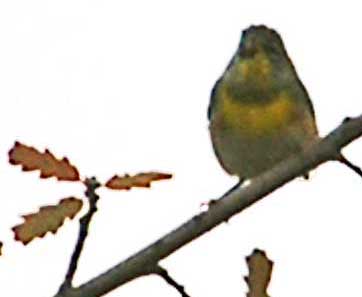 A
very unexpected late December find was this apparent adult male Northern
Parula (right; photo © Mark Kenyon; below,
video capture © Julian P. Donahue) at the Harris Creek access
to Lake San Antonio on 26 Dec 2003. A
very unexpected late December find was this apparent adult male Northern
Parula (right; photo © Mark Kenyon; below,
video capture © Julian P. Donahue) at the Harris Creek access
to Lake San Antonio on 26 Dec 2003.
This is the first winter record for Monterey County; there are a handful of wintering records elsewhere in California, mostly in the south. This warbler was with a mixed flock in blue oaks at the north end of Harris Creek boat launching facility parking lot. The observers were Julian P. & Katharine Donahue, Mark Kenyon, and Clare Marter Kenyon. Given the poor lighting conditions for photography (backlit against overcast sky), we're grateful to get this documentation. |
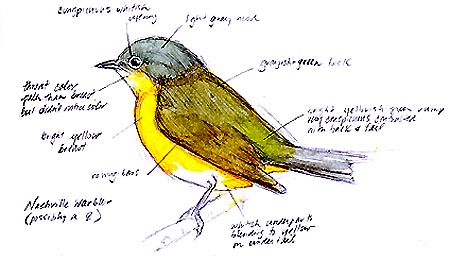 |
As winter approached, rare landbirds that may winter were discovered. Last winter's Black-throated Green Warbler reappeared at Laguna Grande in Seaside on 11 Oct (Tim Amaral +). A Nashville Warbler found there 12 Nov could also be last winter's bird returning. It was very nicely documented in this sketch (left; © Alex Cruz); we wish that all reported rarities were this well documented! Last winter's male Williamson's Sapsucker in Del Monte Forest, Pebble Beach, also reappeared in mid-November (B.J. Weed). |
|
and well-documented with written details by Jim Tietz at the Big Sur R. mouth. Unfortunately, although a few other birders later glimpsed it in the undergrowth or heard its chatter call, it was never again seen well. Efforts on following days were not successful. Still, this is a new MTY record and the first for this species in all of northern California! |
 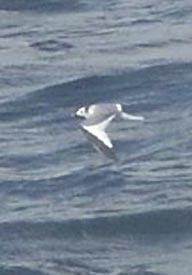 And
speaking of documentation, for the first time ever, Sabine's Gull
was documented on Monterey Bay in November by physical evidence (photos;
right: © Roger Wolfe & D. Roberson, respectively). The latest
fall specimen for MTY was taken by Rollo Beck on 28 Oct 1907 (a juv; #CAS).
In the county database are six prior November records, all of them sight
records. Three were in Nov 1986 following storms, including the latest:
an adult seen off Esplanade, Pacific Grove, on 21 Nov 1986 (B.J. Weed).
Two of the six prior records were juvenals: 10-11 Nov 1985 Monterey harbor
(A. Baldridge) and 9-10 Nov 1986 Pt. Pinos (Lars Jonsson; the famed Swedish
artist). And
speaking of documentation, for the first time ever, Sabine's Gull
was documented on Monterey Bay in November by physical evidence (photos;
right: © Roger Wolfe & D. Roberson, respectively). The latest
fall specimen for MTY was taken by Rollo Beck on 28 Oct 1907 (a juv; #CAS).
In the county database are six prior November records, all of them sight
records. Three were in Nov 1986 following storms, including the latest:
an adult seen off Esplanade, Pacific Grove, on 21 Nov 1986 (B.J. Weed).
Two of the six prior records were juvenals: 10-11 Nov 1985 Monterey harbor
(A. Baldridge) and 9-10 Nov 1986 Pt. Pinos (Lars Jonsson; the famed Swedish
artist).
On 9 Nov 2003, some 9 nmi west of Pt. Pinos, a Monterey Seabirds boat trip found this basic-plumaged adult (right) flying south. This plumage, with its kittiwake-like dark bar on the hind neck, was new to the leaders so skipper Richard Ternullo cranked up the speed in a chase that allowed these shots to be taken. Note the yellow tip to the black bill, ruling out any thought of "Red-legged Kittiwake." However, it is possible that Red-legged Kittiwakes are responsible for a few old reports of Sabine's Gull on Monterey Bay in mid-winter (Dec-Feb). I also find it fascinating that photos taken at more or less the same time could be so different in color tone. Roger Wolfe's photo (near right) is from a digital camera; Don Roberson's pic (far right) is with 200 speed Sensia film. |
 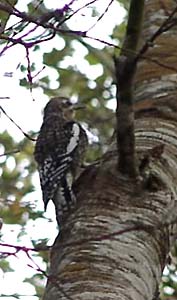
As if to make up for an unusually tepid autumn, the turn from October into November presented a bonanza of interesting birds. A Scarlet Tanager, first discovered on 28 Oct at the Big Sur R. mouth by Matt Brady. It lingered to at least 6 Nov (photo far right, 2 Nov; © D. Roberson) and provided the 3rd MTY record. It seems likely to have been a hatch-year bird but whether a young male or young female was debated. While the lingering tanager set a late date for this county, a juvenal Yellow-bellied Sapsucker, found on 1 Nov at Elkhorn Slough Estuarine Research Reserve by Rick Fournier, is the third earliest fall arrival for this county (photo near right, 2 Nov; © Roger Wolfe). If it should remain to winter, it would push the arrival date for a wintering bird forward a month. The weekend of 31 Oct-2 Nov also saw a significant inshore incursion of Red Phalaropes, first reported by Brian Weed and Alan Baldridge, with hundreds hugging the shoreline of Monterey Bay (photo below © D. Roberson) and others scattered inland as far as Salinas (B.H. Gerow). Lots of N. Fulmars were also in the Bay, and dozens washed up on local beaches, starving in a apparent natural "boom-and-bust" cycle in this northern breeder. |
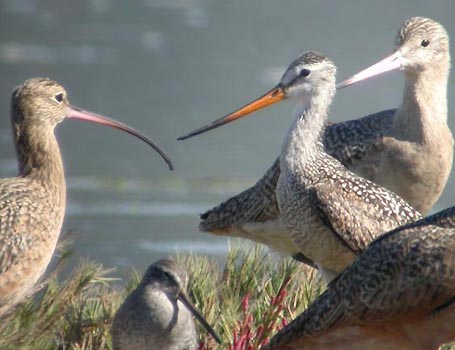 In
late October, an odd godwit, initially identified as Bar-tailed Godwit,
created excitement along Elkhorn Slough; this fine 60X digiscoped image
is by Anne Spence, taken on 27 Oct [© Anne Spence; see her
other images of this bird on
her web site]. It had some features of the Siberian race baueri
of Bar-tailed Godwit (small size, prominent supercilium, barred rump and
tail) but a couple weeks later Dan Singer pointed out significant problems
with this initial i.d., and concluded that it was an aberrant alternate-plumaged
Marbled Godwit still in alternate plumage and now very worn (accounting
for the lack of cinnamon tones). Go to a page
on this godwit for some of the material presented initially on this
page, but with many more images of both this bird and comparative godwits,
and expert commentary. In
late October, an odd godwit, initially identified as Bar-tailed Godwit,
created excitement along Elkhorn Slough; this fine 60X digiscoped image
is by Anne Spence, taken on 27 Oct [© Anne Spence; see her
other images of this bird on
her web site]. It had some features of the Siberian race baueri
of Bar-tailed Godwit (small size, prominent supercilium, barred rump and
tail) but a couple weeks later Dan Singer pointed out significant problems
with this initial i.d., and concluded that it was an aberrant alternate-plumaged
Marbled Godwit still in alternate plumage and now very worn (accounting
for the lack of cinnamon tones). Go to a page
on this godwit for some of the material presented initially on this
page, but with many more images of both this bird and comparative godwits,
and expert commentary. |
|
|
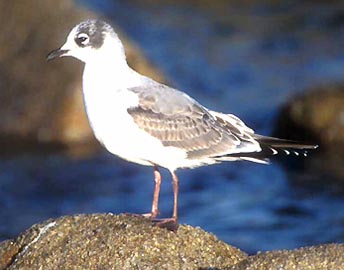 |
 |
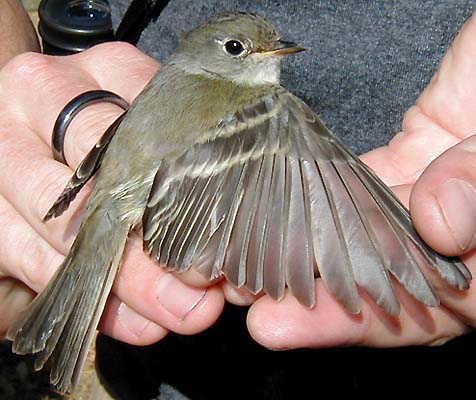 |

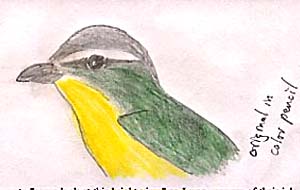 |
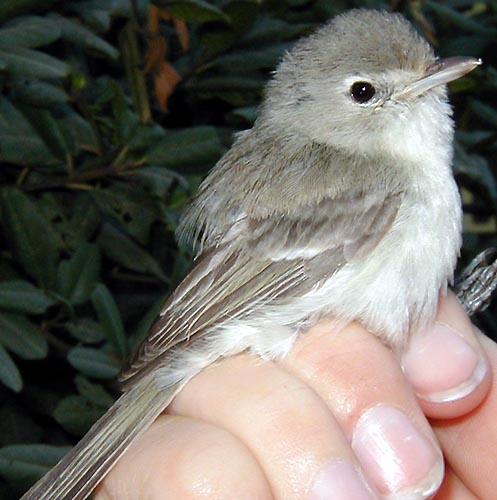 Earlier
in the fall, a
Bell's Vireo (left and below right; photos ©
BSOL, all rights reserved, used with permission) was banded at the
Big Sur R. mouth by BSOL on 9 Sep 2003. The entirely gray-and-white plumage
(with just trace of olive wash to the wing edges) and the measurements
were consistent with the endangered California breeding race V. b. pusillus,
often termed "Least Bell's Vireo." It was aged in-hand as a HY (hatch-year)
bird (by skull) and had rather fresh plumage. The Arizona breeding race
V.
b. arizonae would show yellowish wash to flanks and olive wash to rump
in HY birds, so we may safely consider this to be a record of Least Bell's
Vireo, only the 7th MTY record of this great little bird in the last 25
years. It is only the 2nd fall migrant ever encountered and the first to
be banded. The only other fall migrant was in the headlands patch at Big
Sur R. mouth 20-21 Sep 1995 (Dave Haupt, D. Roberson). Earlier
in the fall, a
Bell's Vireo (left and below right; photos ©
BSOL, all rights reserved, used with permission) was banded at the
Big Sur R. mouth by BSOL on 9 Sep 2003. The entirely gray-and-white plumage
(with just trace of olive wash to the wing edges) and the measurements
were consistent with the endangered California breeding race V. b. pusillus,
often termed "Least Bell's Vireo." It was aged in-hand as a HY (hatch-year)
bird (by skull) and had rather fresh plumage. The Arizona breeding race
V.
b. arizonae would show yellowish wash to flanks and olive wash to rump
in HY birds, so we may safely consider this to be a record of Least Bell's
Vireo, only the 7th MTY record of this great little bird in the last 25
years. It is only the 2nd fall migrant ever encountered and the first to
be banded. The only other fall migrant was in the headlands patch at Big
Sur R. mouth 20-21 Sep 1995 (Dave Haupt, D. Roberson).
It is also only the second Bell's Vireo ever to be photographed in this county. One of three singing males along the Salinas River near Bradley in June 1983 was photographed; that shot is shown below left (photo 19 June 1983 © Don Roberson). One of those males (not the photographed one) attracted a mate, nested, and hatched young that summer. This was the last confirmed nesting for Monterey County. |
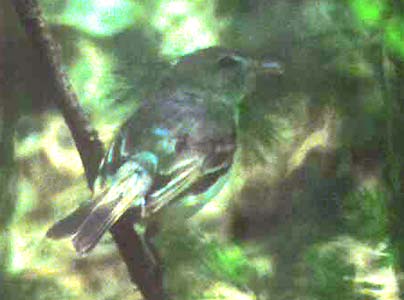 |
| Least Bell's Vireo can be mistaken for Plumbeous Vireo V. plumbeus
(28 MTY records of migrants) or Gray Vireo V. vicinior (no records
anywhere in northern California). Indeed, some first thought this bird
was a Gray Vireo. Both Gray and Plumbeous Vireos are substantially larger
than Least Bell's Vireo. In this particular case the wing chord of 54 mm
and a weight of 8.8 gr are just about at the median of Bell's but well
outside the range of Gray, which has a wing chord of 59-68mm per Pyle's
banding guide (1997) and a weight of 11.5-13.5 (per the BONA account).
Both species have thin wingbars with the lower one most prominent (and
the upper sometimes very obscure). These in-hand photos and the field photo
of the adult Bell's (above left) also show how relatively obscure the eye-ring
may be on Bell's. The dingy spectacles are most prominent through the lores
but very thin around the eye (thickest above the eye; in contrast, our
resident Hutton's Vireo
V. huttoni, which has the opposite pattern:
it has a break above the eye; see
nice photo and discussion on Joe Morlan's site). Plumbeous Vireo has
more prominent 'spectacles' with broad eye-ring (broken in front of eye)
and much more prominent wing bars.
Gray versus Least Bell's Vireo is an under appreciated field problem if size cannot be easily quantified and the birds are not singing. In comparing the photos in my collection and published in the Birds of North America (BONA) fascicles, possible differences may include:
|
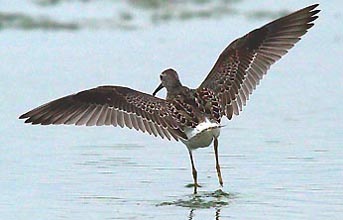 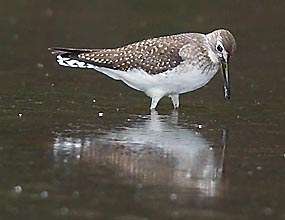 Fall
migration began, as always, with adult shorebirds in late June-July and
then a flood of juvenal plumaged waders in August. This was quite a good
fall locally for Solitary Sandpipers. Birds were found near Moss
Landing (Rick Fournier), Ft. Ord (David Styer), near Salinas (Bruce Gerow,
Blake Matheson) and Carmel R. mouth (Nancy McMahon). The latter was photographed
on the latter date by Bill Hill on 3 Sep (right or above, left-hand shot;
photo
© Bill Hill). Another scarce wader found in higher than usual
numbers was Stilt Sandpiper (right or above; right-hand photo
© Bill Hill). Three birds were scattered from Salinas (one an
adult & the other a juv.; Bruce Gerow) to Moss Landing (Rick Fournier) Fall
migration began, as always, with adult shorebirds in late June-July and
then a flood of juvenal plumaged waders in August. This was quite a good
fall locally for Solitary Sandpipers. Birds were found near Moss
Landing (Rick Fournier), Ft. Ord (David Styer), near Salinas (Bruce Gerow,
Blake Matheson) and Carmel R. mouth (Nancy McMahon). The latter was photographed
on the latter date by Bill Hill on 3 Sep (right or above, left-hand shot;
photo
© Bill Hill). Another scarce wader found in higher than usual
numbers was Stilt Sandpiper (right or above; right-hand photo
© Bill Hill). Three birds were scattered from Salinas (one an
adult & the other a juv.; Bruce Gerow) to Moss Landing (Rick Fournier)
The most spectacular birds of the early fall were just a couple miles offshore from Pt. Pinos: a first county (and only 2nd California) Cory's Shearwater on 22-23 August (Richard Ternullo, Nancy Black, Roger Wolfe, Steve Bailey) and the 8th county record for Streaked Shearwater on 23 August (Steve Bailey, Roger Wolfe). Later, in October, a Greater Shearwater was reported twice (R. Ternullo, R. Wolfe). Passerine migration also began well with two Painted Buntings at Big Sur R. mouth 31 August (Steve Rovell, Craig Hohenberger, Dave Werner) with one remaining into the next morning. Another (or one of the same lingering?) was seen upstream near BSOL on 16 Sep. |
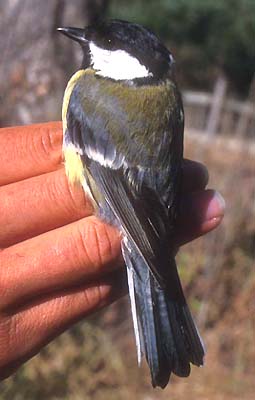 |
|
|
|
|
|
OF THE SECOND HALF ON 2003 (June - Dec) CLICK HERE FOR FIRST HALF HIGHLIGHTS |